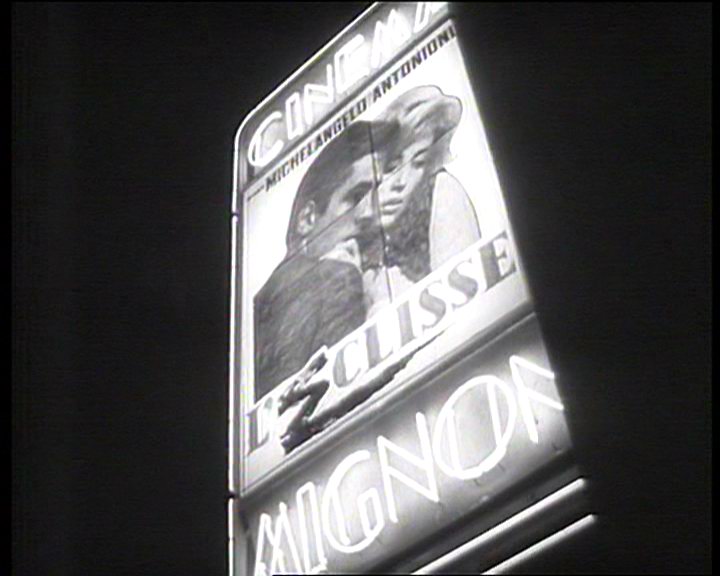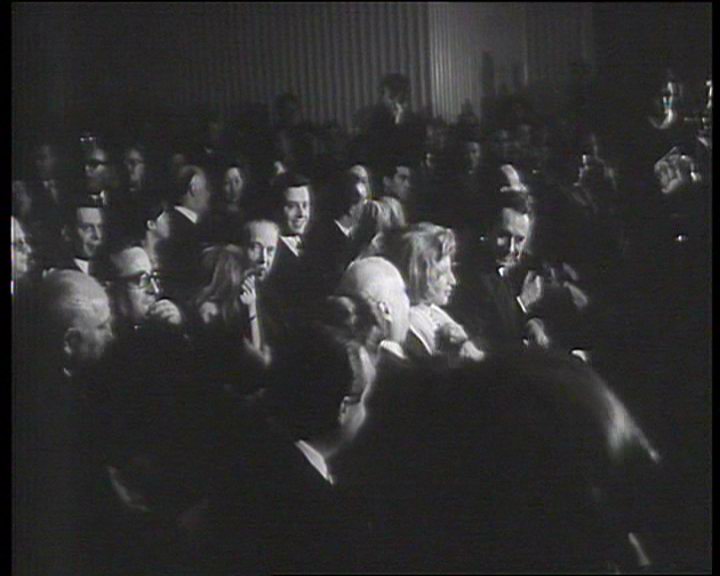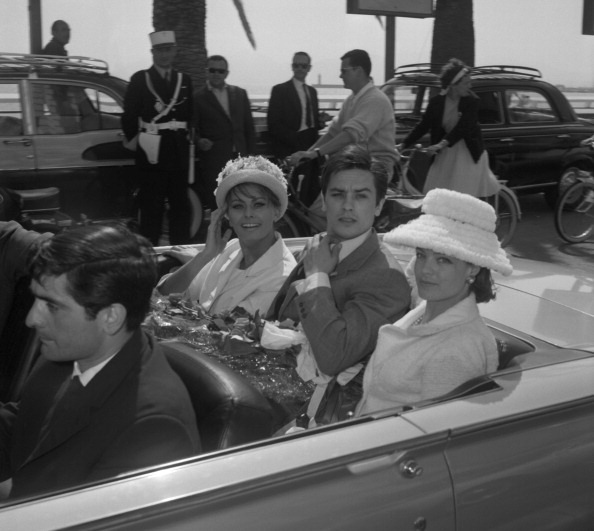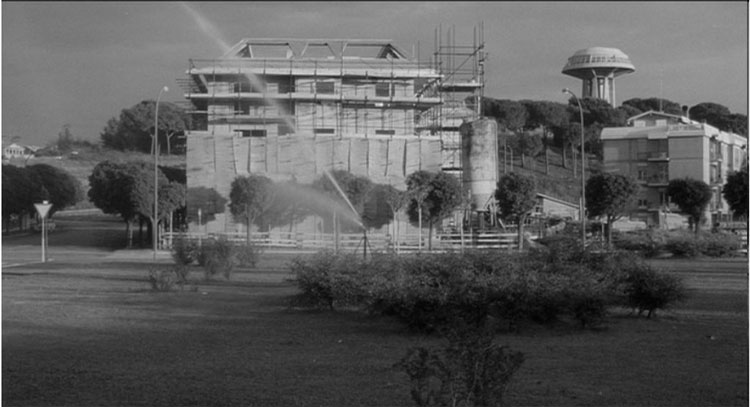MICHELANGELO ANTONIONI’S L’ECLISSE
a broken piece of wood, a matchbook, a woman, a man
[NOTE: TEXT SIZE MAY BE INCREASED BY PRESSING SIMULTANEOUSLY "Ctrl" AND "+" KEYS OR BY OTHER METHODS]
I. THE BEGINNING OF THE END
Strange now to think of you, gone . . .
“Kaddish”
Allen Ginsberg
L'eclisse (The Eclipse; Pronunciation of “eclisse”*) begins at the end. The opening scene concerns the breakup of Vittoria and Riccardo. Some two hours later this rupture is reprised when both Vittoria and her new lover, Piero, fail to meet at their appointed rendezvous at film’s end. We are, as it were, back where we started, the circle closed. Between these two endings, or perhaps better said—within the space enclosed by a zero—is a movie made by a man whose identity, like that of his film, remains uncertain.
L'eclisse has never been a popular film. Even Antonioni does not regard it as among his “favorite” films, and indeed, in a recent interview conducted with the aid of his wife, Enrica Fico, remarked, “. . . how crazy was I to shoot the end of L'eclisse?” (“. . . quando vedo ‘Deserto rosso’ mi rendo conto che è un film strano e mi dico, ‘Come sono stato pazzo! La stessa cosa la penso per la fine di ‘L'eclisse.’ ” [see A. Mattanza, bibliography]). After premiering on April 12 of 1962 at the Cinema Mignon in Milan (L’eclisse was shot in the latter half of 1961 between approximately 19 July and October), the film enjoyed little commercial success anywhere in the world with the notable exception of Japan.1 Alain Delon did not attend this Italian premiere, reprising his role as Piero and not showing up (Delon did attend the presentation of L'eclisse in Cannes on 7 May 1962). The Cinema Mignon was subsequently chopped up into a “multiplex theatre” in 1999, renamed the “Excelsior,” which in turn was closed in 2007. L'eclisse was itself sliced and diced from its very release, being 125 minutes long in Italy and 130 minutes in Cannes (The American Film Institute Catalog: Feature Films, 1961-1970, Part 2, [page 296]).

Marquee of Cinema Mignon, Milan
12 April 1962

Italian premiere of L'eclisse with Monica Vitta illuminated by light,
surrounded by a crowd of mostly men, including—to her left—Michelangelo Antonioni
What light is light, if Monica be not seen? "The Two Gentlemen of Verona" (III.i.170-187)

Alain Delon aka Piero on the Promenade de la Croisette of Cannes in the back seat of a fancy convertible flanked by two beautiful women
(Sophia Loren and Romy Schneider)
Monica Vitti aka Vittoria nowhere to be seen
Among Antonioni’s films made after 1959, L'eclisse has sold less tickets than any of his other films. Time has done little to alter this situation. Indeed, the film is even less well known today than it was at the time of its release. Nowadays, few American university students have ever even heard of Antonioni. Even among American university cinema majors their knowledge of Antonioni may be limited to having heard of Blow-Up or L’avventura, if that. With regard to America, ignorance concerning Antonioni and in particular, L'eclisse, may not seem surprising. After all, the film is European, is 45 years old, is in black and white, has subtitles, and features actors who are not household names in the United States. Even in Italy and France, however, the film has never enjoyed any significant degree of popular success. Likewise, film criticism of L'eclisse is relatively scanty compared to other films of Antonioni’s mature period. All of this may seem surprising when one considers that--at least for Western Europeans--the film stars two giants of European cinema and concerns love, violence, and money. It may seem quite curious to now write an entire book in English on the subject of a relatively obscure, unpopular film directed by a notoriously austere and “difficult” European director. (I shall henceforth refer to this binary assemblage of 0's and 1's as a “book,” although it is either less or more than that; regardless, at present no conventional, published book of these words you are now reading exists outside of the confines of cyberspace.) This may be true insofar as I believe that L'eclisse is never destined to become a particularly popular film. Nevertheless, I also believe that--as Seymour Chatman hints at in the last paragraph of his book on Antonioni--L'eclisse is one of the “best” movies ever made.* I write this with a smile on my lips insofar as I wonder if there are only thirty six people on the planet Earth--perhaps limited to the Tzadikim Nistarim--who when given a chance and a guidebook such as this book that I have written, will agree with this assessment. The common consensus of the remainder of the planet will be that L'eclisse is a tedious, abstruse, and slow-moving film. In the 1962 masterwork of Dino Risi, Il sorpasso, the main character, Bruno, played by Vittorio Gassman--a kind of narcissistic second cousin of L’eclisse’s main character, Piero, played by Alain Delon--asks the young, ingenuous law student, Roberto, played by Jean-Louis Trintignant: “L’hai visto L’eclisse? Io c’ho dormito. ‘Na bella pennichella. Bel regista Antonioni! C’ha un Flaminia Zagato, una volta sulla Fettuccia di Terracina m’ha fatto allunga’ il collo!” / “Have you seen L’eclisse? Antonioni, a good director, but that movie, it put me to sleep. . . .” If Piero could step off the screen and see L’eclisse my guess is that he, too, would fall asleep. The irony here is that the narcissism and lack of insight of both Piero and Bruno prevent them from truly recognizing themselves in a mirror or, in the case of Bruno, from recognizing himself as the character Piero in another film, L’eclisse. Such a lack of “outsight” is a grave sin of many of the characters in the films of Antonioni. For such predominantly male characters, not being able to see is akin to another kind of blindness, that of not being able to comprehend. There are other strong and curious resonances between Il sorpasso and L’eclisse, not the least of which is that the Bruno/Gassman character of Il sorpasso poses the above question while driving a white convertible Lancia Aurelia Sport, which like the Alfa spyder of L’eclisse, will be transformed from a flashy sports car into a hearse. (The only thing that really impresses Bruno about Antonioni is that Bruno believes that Antonioni once [may, or may not] have driven a fancy sports car--a Flaminia Zagato--on a famous stretch of the antica via Appia near the town of Terracina some 50 kilometers southeast of Rome; the point Risi is apparently making is that Bruno, a fictional character in a movie, is more impressed by the car that Antonioni, the movie director, drives in “real life” than by Antonioni’s movie, L'eclisse.) In fact, Il sorpasso--an ostensible comedy--is as infused with Death as is L'eclisse or Rossellini’s Viaggio in Italia, the latter film itself a reworking of Joyce’s “The Dead.”
L'eclisse consists of a series of loosely linked episodes. The narrative trajectory is conventional in many ways. For example, the time line is linear, and does not involve flashbacks or other manipulations of chronology. (In this regard it is similar to La dolce vita, a rich film with a relatively simple time line.) The plot itself is threadbare, and might be explained as “Girl loses boy, girl finds new boy, girl and boy lose each other.” (As opposed to Raymond Bellour’s observation: “ ‘Boy meets girl, boy loses girl, boy gets girl’… organizes, indeed constitutes, the classical American cinema as a whole.” Quoted by James MacDowell. Retrieved 20 January 2007 from: <http://www.alternatetakes.co.uk/?2005,9,24>). And yet, this film is often viewed as problematic and abstract, among the more difficult of Antonioni’s films. The complexity lies not in its conventional narrative permutations, but elsewhere. L'eclisse, like all of Antonioni’s films, is an intricately conceived structure that is held together by thematic as opposed to conventional storytelling mortar. Scenes occur because they embody thematic concerns, not because they are part of a plot per se.*
One might say that for Antonioni, theme is plot. There is even the sense that--unlike most film--all scenes are created equal, none more important thematically than others. This aspect can deny usual viewer expectations in which one scene is meant to build upon another, in which narrative hills and valleys occur. Instead, with Antonioni we are presented with a series of tableaux that are only superficially related in terms of raw plot. In this regard, scenes may appear digressive, arbitrary, and inexplicable. For instance, the lengthy segment of L'eclisse regarding the flight to Verona does not advance the narrative of the film in any obvious way. In reality, nothing much happens. Why then, did Antonioni film it? For the naïve viewer the answer is an unfamiliar one: the segment is a gold mine of concealed, thematic riches, as opposed to the pleasures of most commercial films, overt sex and violence (“Kiss Kiss Bang Bang”). Simply put, an Antonioni film requires interpretation or “translation.” One must be continually on the lookout for where the real “action” takes place, which is always on the level of the thematic and intellectual.* In this regard, analyzing an Antonioni film is vaguely analogous to psychoanalysis: one does not accept things at face value, true meaning often being latent. Commercial films generally treat the viewer as if he were a John and the experience supine. Importantly, however, even these films appeal to largely subconscious appetites of which the client-audience and sometimes even the filmmaker herself/himself is largely unaware. (Garrett Stewart in his book, Framed Time, writes [p. 3], “Some films think through what others leave merely intuited or scurry to displace. Films that don’t even seem to know what they’re doing may nonetheless do what they too well know--and thus act out their own repressions for all to see.”) In an Antonioni film, if explicit sex or violence occur, the real action--with regard to directorial intent--always lies elsewhere. Both Piero and his predecessor, Sandro of L’avventura, are obsessed with chasing women. They do not know why they chase women, nor can they even begin to understand that their erotomania is a symptom precipitated by a more fundamental conflict. Unlike most movies, such womanizing is not a cinematic end in itself. For Antonioni, even sex finally doesn’t have much to do with sex.* No gratuitous events occur, for even the smallest action bears thematic import. Take, for example, the breaking of the ashtray in the opening scene of L'eclisse, or its atavist in L’avventura, the breaking of the ancient amphora by Raimondo. In the first case the broken ashtray speaks to the profound theme of the volition of inanimate objects, and is linked to the later ripping of Vittoria’s dress as well as to the broken piece of wood floating in the “barrel” (200 L open top steel drum) of the Eur. (Acronym for “Esposizione Universale Roma,” a modern quarter of southern Rome where Antonioni had himself briefly worked in the late1930’s; pronounced in Italian as two syllables, “Ā'OOR”; long “Ā”; “OOR” as in the English word, “your,” without the “y”. Or, alternatively, employing the International Phonetic Alphabet: ['eʊər]. Not to be confused with the “euro” (€), the present common currency of 13 European nations.)*

The Wasteland
I saw with my own eyes the Sibyl at Cumae hanging in a cage, and
when the boys said to her: “Sibyl, what do you want?” she answered:
“I want to die.”
In the second case, the broken vase speaks, among other things, to the theme of the disturbing disconnection between modern man, his environment, and his past. As in so many of Antonioni’s films, things incessantly repeat themselves, and again a vase breaks in a Paris apartment in Antonioni’s last film, Par-delà les nuages. A vase mysteriously appears twice in Ozu’s sublime Late Spring (“Banshu” [1949]), unbroken, an affirmation of the human condition, of existence, as opposed to Antonioni’s lifelong attempt at effacing the world and its beings, Antonioni’s abiding apocalyptic vision. And what are we to make of the broken guitar of Blow-Up?
An Antonioni film requires active engagement by the viewer. The films must be closely read. If one does not deliberately attempt to comprehend the film, the film becomes incomprehensible, or worse yet, boring (“Antoniennui”), two accusations commonly leveled at Antonioni. (Pauline Kael, no admirer of L'eclisse, referred to the film as “Some like it cold.”) To paraphrase Socrates, the unexamined Antonioni film is not worth viewing. To the engaged viewer of L'eclisse--what might to the disengaged viewer seem tedious, slow-moving, and uninteresting--becomes thrilling. The richness of an Antonioni film is such that a single viewing is generally never sufficient to “see” the film.
Nevertheless, Antonioni’s films do not follow any systematic dogma as dictated by, say, Marx or any particular film school, nor do they require much advance knowledge of a didactic nature in order to understand specific references, allusions, or symbols, which largely do not exist in any conventional sense in his movies. One might go so far as to say that, ultimately, there is nothing to understand. Credentials are not required for admission; the right high school drop-out with a native intelligence, good eyesight, and street smarts might do as well, or better, than a highly titled intellectual with an impressive curriculum vitae who is utterly blind. Vittoria, a “mere” translator, is clearly less educated than Riccardo, but more in tune with the divine oscillations of the universe than the cultured, leftist intellectual who is her employer and lover. One must be inquisitive, open, actively engaged, and preferably have suffered a bit in love, which means that most viewers will come to Antonioni’s film with at least the latter life experience already in their résumé. A tour guide of a calibre less than that of Virgil who accompanies a tourist less brilliant than Dante might, however, be of some modest assistance in the descent and ultimate ascent into Antonioni’s films.*
Virtually every scene in a mature film by Antonioni may be analyzed in terms of the specific theme being highlighted. There is such a deliberateness—an austere, claustrophobic, auteurial control to a film by Antonioni—that one must constantly ask, no matter how trivial the event or small the detail, “Why is Antonioni doing what he is doing?” Pierre Leprohon (p.88) cites a 1959 interview published in Positif in which Antonioni said:
Reality changes so rapidly that if one theme is not dealt with, another presents itself. Allowing one’s attention to be attracted by each little thing has become a vice of the imagination. All one has to do is to keep one’s eyes open: everything becomes full of meaning; everything cries out to be interpreted, reproduced. Thus, there is no one particular film that I would like to make; there is one for every single theme I perceive. And I am excited by these themes, day and night.
Because virtually everything in an Antonioni film, particularly L'eclisse, is potentially significant, the films--however elegantly simple on the surface--are among the most “dense” films ever made. The density, however, is of a different kind than that of Joyce’s Ulysses, a work that is also remarkably dense, but saturated with allusions. Such Joycean allusions to specific events, places, and people in the Dublin of June 16, 1904 with their superimposed mythological and other references do not apply to Antonioni’s vision of Rome in the summer of 1961. The objects and people that populate Antonioni’s Rome are less specific and more generic. While Ulysses could only have taken place in Dublin, it might be argued that L'eclisse could have been set in London, Blow-Up in Rome (or Milano), and that Zabriskie Point need not have faithfully recreated the California of the late 1960’s. (Antonioni seems to have confronted the criticism that Zabriskie Point did not accurately portray America by suggesting that his artistic goal was not to recreate in a literal manner a state which he admitted was foreign to him.) As will be shown later, to the model, Verushka of Blow-Up, London and Paris are somehow the same. Curiously, not a single, major film of Antonioni takes place entirely within the confines of a single city.
In lieu of the kind of specific allusions and references that populate all of Ulysses, in L'eclisse there are instead a number of major organizing themes which repetitively “explain” one scene after another. As William Arrowsmith has pointed out, Antonioni’s canon is a true, homogeneous œuvre in the sense that his films tend to be contiguous with similar themes appearing over and over again. Peter Brunette in his study of Antonioni appears to touch upon this important aspect of Antonioni’s films when he writes, “. . . a strange feeling of simultaneity and repetition results. This leads once again to the impression that we are watching a drama of forms [Brunette’s italics] as much as a drama of people.”
Brunette also uses the adjective, “permeable,” to describe the boundaries that in general exist between the individual films of an auteur. In Antonioni’s case, the boundaries are particularly porous. Indeed, Brunette suggests that “. . . it seems productive to efface boundaries between films.” . . . as if Antonioni had made only one film instead of many (reminiscent of the observation by Jean Renoir that “A director makes only one movie. Then he breaks it into pieces and makes it again.”). Biarese and Tassone (p. 155) quote R. Benayoun as observing that with regard to Antonioni’s The Passenger, “L’avventura di questo Vinto si chiude con la sua Eclisse.” (“L’avventura of I vinti concludes with L'eclisse.”) The number and degree of similarities and correspondences between L'eclisse and other Antonioni films are remarkable.2
One reason that might in part explain the homogeneity of Antonioni’s films, as well as the recurrence of certain patterns, is the relatively restricted range of his cinema. As Moravia, who I believe was an admirer of Antonioni, has written of the filmmaker, “È come certi uccelli solitari che hanno un verso solo e lo provano notte e giorno. Attraverso i suoi film egli ci ha dato questo suo verso e soltanto questo.” ([Antonioni] is like certain solitary birds that have but one song, a tune they sing all day and night. In his films he has sung to us but this one song.”). A crude profile for almost all of Antonioni’s films would be as follows: Antonioni’s movies are usually contemporary dramas of a highly aesthecized and intellectual nature with a skeletal plot, sober tone, generally dealing with adult characters from the middle or upper classes who are experiencing a romantic conflict, often adulterous.* In addition to these narrative and other descriptors there are also certain stylistic features present in almost all of the films, examples being Antonioni’s long takes, a general avoidance of all things theatrical (preferring, for example, naturalistic settings as opposed to sets), frequent violation of standard cinematographic rules such as the “180 degree rule,” avoidance of standard cinematic techniques such as shot-countershot, lack of exposition, frequent use of ellipses in scene transitions, the meticulous habit of carefully “framing” characters in a particular, “Euclidean” manner with their environment (characters often in profile at 90 degrees with one another), recurrent employ of favored images and motifs such as window grills, reluctance to employ commentative music, preference for exotic, often aquatic-themed location shooting, tangential, apparently unmotivated scenes interrupting continuity, frequent casting of Monica Vitti, and many others. Tone and viewpoint are invariably neutral, the creator distanced from his carefully wrought creation.
This book is an attempt to identify those themes which characterize L'eclisse and to identify such themes in other films by Antonioni. (Acceptable substitutes for the word “theme” might be form [à la Brunette], motif, pattern, organizing principle, trait, or even issue or concern.) It is my belief that Antonioni constructed L'eclisse in the most meticulous and self-conscious of manners. However, even if this were not the case, a work of art that is true to life may still yield itself to a close thematic analysis. This is true, if only because life itself--however chaotic its surface--has its patterns.* The secret for great filmmaking is perhaps knowing what to point the camera at. The recipe is otherwise straightforward: Get a camera, turn it on, point it at life, add no additional spices, flavoring, meaning, or significance. Life can speak for itself. Must we only learn how to look and listen? Or, as in the case of David Locke of The Passenger, how to be?